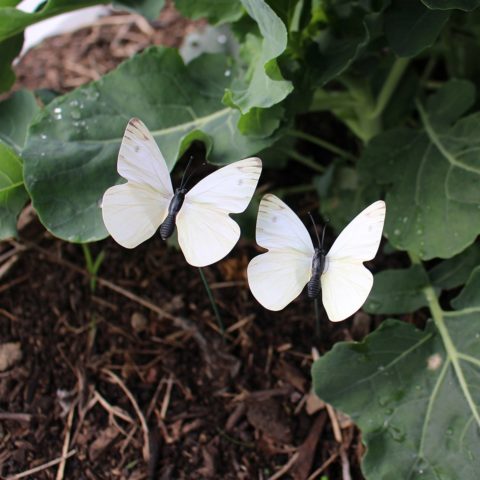How to Control Cabbage Moths, Butterflies and Caterpillars
 Home grown brassicas such as broccoli, cauliflower, cabbage, kale, Brussel sprouts, Savoy cabbage, kohlrabi, rocket and mustard greens are a popular choice in any vegetable garden. They are delicious eaten fresh from the garden – for both humans and pests!
Home grown brassicas such as broccoli, cauliflower, cabbage, kale, Brussel sprouts, Savoy cabbage, kohlrabi, rocket and mustard greens are a popular choice in any vegetable garden. They are delicious eaten fresh from the garden – for both humans and pests!
Just when the plants are at their most delectable, the brassica loving cabbage moths and cabbage white butterflies can be seen flitting around the garden. The adults dancing around the vegetable garden are the parents of those pesky caterpillars that seem to devour prize veggies almost overnight. These voracious pests grow very fast and chew holes in leaves, destroying the foliage, eventually killing the plant and causing heartache for the home gardener.
Option 1: Netting
卡特彼勒是最简单的方法来控制eliminate the eggs by preventing the adult from laying. It is possible to put fine netting over the plants however this method limits access to the plants and makes it difficult to cultivate the garden. If there are any eggs already on the plants, it gives the newly hatched caterpillars free reign to chomp on the vegetables safe from any predators.
Option 2: Plant Decoys
Growing other plants attractive to the egg-laying adults, such as nasturtiums, dill and mustard, and trick them into laying on another plant away from edible crops. There are other decoy plants, such as land cress, which have toxins in the leaves lethal to caterpillars. The adult will lay the eggs on these delicious decoys, then the caterpillars eats the leaves and dies, stopping the breeding cycle for the pest.
Some strongly scented herbs, such as lavender, sage and rosemary, seem to deter the adults from moving in a laying their eggs. Even garlic can be used as a barrier planting around the border of the vegetable garden.
Option 3: Trick with Deterrents
When the adult moth is ready to lay her eggs, she will search for a suitable position with plenty of food for her offspring and no competition. The adult moth is territorial and won’t go into an area that is already populated by another moth.
Take advantage of this habit and create a fake moth that acts like a ‘scarecrow’. The Cabbage Moth Deterrent is a fake moth on a long stake. The lightweight wings move with the breeze, creating a very lifelike deception. It tricks the moth into thinking your patch is already taken and encourages her to move on to a less populated spot.
Place the deterrents in the veggie patch and protect your crops from caterpillar attack without the need for chemical sprays on your edibles.
Option 4: Manual removal
Despite your best efforts at prevention, if you face an attack from these very determined pests, you need to act quickly to save your plants. When you see evidence of caterpillar invasion, a keen eye and persistence are called for. Inspect the plants, particularly the underside of the leaves and heart of the plant, then remove and destroy the caterpillar. You will have to repeat this task every day to get on top of the larvae population. Also remove any eggs you see on the plants to prevent new larvae hatching.
Option 5: Pesticide
If they already have the jump on you and there are too many to control by hand, you may have to resort to an insecticide. The natural pesticide, called pyrethrum, works against a range of pests, including caterpillars, however it is also lethal for beneficial insects such as ladybirds.
基于细菌的年代prays, commonly sold as Dipel, are highly selective, harmless for birds and other wildlife, safe for food crops and are classed as organic. It kills the caterpillars after they eat treated leaves and several applications may be required to control an infestation.
Multi-pronged Approach
A multi-pronged approach is the best way to control a caterpillar problem. Grow plenty of flowering plants that attract predator insects to feed on the caterpillars. Dig over any fallow areas of the veggie garden to expose dormant pupae in the soil as food for hungry birds. Plant a living mulch with white flowers around the plants to act as a decoy in the same way as the fake moth decoy.
Moths and butterflies are mostly beneficial visitors to the garden, however you need to act quickly and firmly if you want to save your brassicas from destruction. Take a regular stroll through the vegetable garden with a cup of tea or a glass of wine and look for tell-tale signs of unwanted pests – holes chewed in leaves, plants bitten to the base, wilted bare stems. Examine the plants closely for evidence of the pesky pest responsible and put your eradication plan into practice.
This is intended as general information only. Please ask one of our horticulturists for specific advice for your situation
Why not try Cabbage Moth Deterrents?
Want to keep a copy of this information for yourself? Download a copy to your computer.

